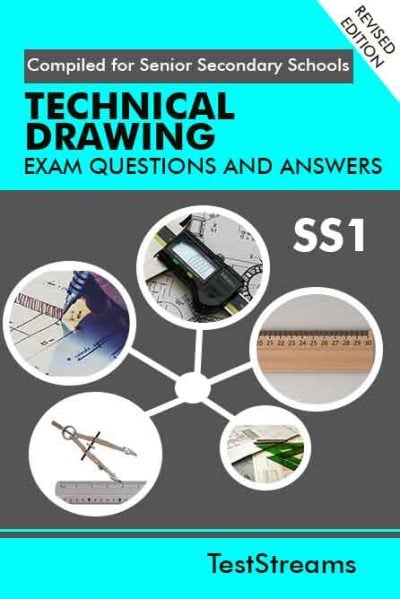These Technical Drawing questions and answers were pulled from our book (Technical Drawing questions for SS 1); Compiled to serve as a reference material to help teachers draw up test and exam questions faster. It could also help students assess their level of exam preparation. Each sample question includes correct answers.
Sample Technical Drawing Exam Questions and Answers
TOPIC: CONIC SECTION
DIRECTION: Choose the correct answer from the lettered options.
1. Which of the following is not a conic section?
A. A frustum
B. A circle
C. An ellipse
D. A triangle
2. The part of a circle bounded by an arc and a chord is called __________.
A. an arc
B. a quadrant
C. a sector
D. a segment
3. A cutting plane through the axis of a right cone will produce ________.
A. a parabola
B. an ellipse
C. a triangle
D. a hyperbola
4. The circle drawn is ___________.
A. circumscribed
B. escribed
C. concentric
D. eccentric
Click here to get the complete Technical Drawing questions for SS 1
5. The space between two concentric circles is called __________.
A. segment
B. sector
C. annular
D. quadrant
TOPIC: FREE HAND DRAWING – DRAWING INSTRUMENT
DIRECTION: Choose the correct answer from the lettered options.
1. Which angle in the options can not be constructed using only a straight edge and a pair of compasses?
A. 150o
B. 100o
C. 45o
D. 111⁄4o
E. 17⁄8o
2. Which combination of instruments are ideal for drawing a horizontal line?
A. Tee-square, pencil, board.
B. Set-squares, pencil, board.
C. Rule, protractor, pencil.
D. Rule, pencil, dividers.
E. Rule, dividers, compasses.
3. Which of the following grades of pencil is most suitable for free hand sketching?
A. B
B. HB
C. 4H
D. 5H
E. 6H
4. Which of the following angles cannot be constructed with the pair of compasses?
A. 221⁄2o
B. 371⁄2o
C. 105o
D. 1121⁄2o
E. 115o
5. The following are uses of free hand sketch except to __________.
A. convey designer’s idea to the draughtsman
B. convey information obtained from one place to teh other
C. help convert orthographic to isometric views
D. serve as a working drawing
E. supply a three-dimensional view of an object to help in interpreting orthographic view










